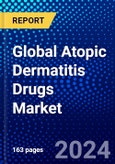The Global Atopic Dermatitis Drugs Market is estimated to be USD 8.21 Bn in 2023 and is expected to reach USD 11.42 Bn by 2028 growing at a CAGR of 6.81%.
However, poor reimbursement policies in developing regions worldwide are expected to be major restraints on the atopic dermatitis market's growth, whereas allergic reactions to off-label therapies and product patent expiration are creating challenges for the market's growth during the forecast period.
2. Bayer strengthens collaboration with One Drop via nearly $100M in new investment, commitments - 24th August 2020
Market Dynamics
The major factor driving the growth of the global atopic dermatitis drugs market is the growing incidence of food allergies exacerbating atopic dermatitis, increasing emphasis on systematic therapies, increasing pharmacological products in developing countries, and the rise in awareness regarding the availability of treatments for the disease. Furthermore, the rising adoption of targeted treatments such as Eucrisa and Dupixent is propelling the market. In addition, government initiatives to provide better and more inexpensive treatment and the availability of advantageous reimbursement rules are anticipated to provide more opportunities for the growth of the market.However, poor reimbursement policies in developing regions worldwide are expected to be major restraints on the atopic dermatitis market's growth, whereas allergic reactions to off-label therapies and product patent expiration are creating challenges for the market's growth during the forecast period.
Market Segmentation
- The Global Atopic Dermatitis Drugs Market is segmented further based on Drug Class, Route of Administration, and Geography.
- By Drug Class, the market is classified into biologics, calcineurin inhibitors, corticosteroids, and pde4 inhibitors. Amongst all, the biologics segment is estimated to hold the highest market share during the forecast period.
- By Route of Administration, the market is classified injectable, oral, and tropical. Amongst all, the injectable segment is estimated to hold the highest market share during the forecast period.
- By Geography, North America is projected to lead the market.
Recent Developments
1. Sanofi buys US biotech company Principia for $3.4bn. - 17th August 20202. Bayer strengthens collaboration with One Drop via nearly $100M in new investment, commitments - 24th August 2020
Company Profiles
Some of the companies covered in this report are AbbVie Inc, Bausch Health Companies Inc, Bayer AG, Biofrontera AG, etc.Competitive Quadrant
The report includes Competitive Quadrant, a proprietary tool to analyze and evaluate the position of companies based on their Industry Position score and Market Performance score. The tool uses various factors for categorizing the players into four categories. Some of these factors considered for analysis are financial performance over the last 3 years, growth strategies, innovation score, new product launches, investments, growth in market share, etc.Why buy this report?
- The report offers a comprehensive evaluation of the Global Atopic Dermatitis Drugs Market. The report includes in-depth qualitative analysis, verifiable data from authentic sources, and projections about market size. The projections are calculated using proven research methodologies.
- The report has been compiled through extensive primary and secondary research. The primary research is done through interviews, surveys, and observation of renowned personnel in the industry.
- The report includes an in-depth market analysis using Porter's 5 forces model and the Ansoff Matrix. In addition, the impact of Covid-19 on the market is also featured in the report.
- The report also includes the regulatory scenario in the industry, which will help you make a well-informed decision. The report discusses major regulatory bodies and major rules and regulations imposed on this sector across various geographies.
- The report also contains the competitive analysis using Positioning Quadrants, the Proprietary competitive positioning tool.
Report Highlights:
- A complete analysis of the market, including parent industry
- Important market dynamics and trends
- Market segmentation
- Historical, current, and projected size of the market based on value and volume
- Market shares and strategies of key players
- Recommendations to companies for strengthening their foothold in the market
Table of Contents
1 Report Description
2 Research Methodology
3 Executive Summary
4 Market Influencers
5 Market Analysis
6 Global Atopic Dermatitis Drugs Market, By Drug Class
7 Global Atopic Dermatitis Drugs Market, By Route of Administration
8 Global Atopic Dermatitis Drugs Market, By Geography
9 Competitive Landscape
10 Company Profiles
11 Appendix
Companies Mentioned
- AbbVie Inc.
- Bausch Health Companies Inc.
- Bayer AG, Biofrontera AG
- Bristol-Myers Squibb Company
- Connectics Corporation
- Eli Lilly and Company
- Encore Dermatology, Inc.
- Fujisawa Healthcare
- Galderma S.A.
- GlaxoSmithKline PLC
- Hoffmann-La Roche AG
- LEO Pharma A/S
- Meda AB, Mylan N.V.
- Novartis AG
- Pfizer Inc
- Regeneron Pharmaceuticals, Inc
- Sanofi S.A.
- Teva Pharmaceutical Industries Ltd
Table Information
| Report Attribute | Details |
|---|---|
| No. of Pages | 163 |
| Published | February 2024 |
| Forecast Period | 2023 - 2028 |
| Estimated Market Value ( USD | $ 8.21 Billion |
| Forecasted Market Value ( USD | $ 11.42 Billion |
| Compound Annual Growth Rate | 6.8% |
| Regions Covered | Global |
| No. of Companies Mentioned | 18 |









